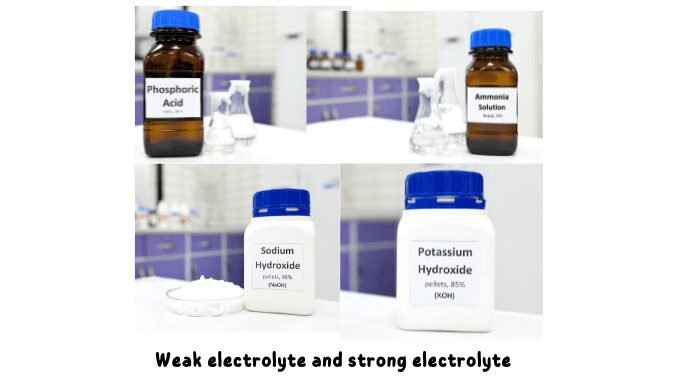
1. Weak electrolyte definition
Weak electrolyte are those electrolytes that have a low degree of dissociation at higher concentrations and hence their conductivity increases with an increase in dilution. Consequently the number of ions in the total volume of electrolyte increases.
Examples
- CH3COOH (Acetic Acid),
- H2CO3 (Carbonic Acid),
- NH3 (Ammonia),
- H3PO4 (Phosphoric Acid),
- C6H5COOH (Benzoic Acid),
- C2H2O4 (Oxalic acid)
- CH2O2 (Formic acid)
2. Weak electrolyte examples
1. CH3COOH (Acetic acid)
On dissociation, acetic acid resolves into CH3COO– and H+. And not all of its hydrogens dissociate. This happens because the hydrogen ion of the carboxylic part is free to evolve.
2. H2CO3 (Carbonic Acid)
Carbonic acid is a weak acid, that is it does not easily release hydrogen ions after dissociation. It is because HCO–3 is a less stable compound and tends to acquire hydrogen ions again after dissociation. Hence, results to be a weak electrolyte.
3. NH3 (Ammonia)
It is a basic compound that is also a weak electrolyte. This compound also gives less number of ions on dissociation which makes its solution a poor conducting electrolyte.
3. Weak electrolytes lists
Name |
Molecular Formula |
|---|---|
| Acetic Acid | CH3COOH |
| Oxalic Acid | C2H2O4 |
| Pyridine | C5H5N |
| Ammonia | NH3 |
| Phosphoric acid | H3PO4 |
| Carbonic Acid | H2CO3 |
4. Strong vs Weak electrolytes
Factors |
Strong Electrolytes |
Weak Electrolytes |
Ionization |
These are fully ionized and have comparatively more ions. | These are partially ionized and have comparatively fewer ions. |
Conductivity |
Have high conductivity due to the presence of more ions. | Have poor conductivity or in some cases, it is very less. |
What groups fall in this category? |
Strong acids, strong bases, and salts fall in this group. | Consists mostly of weak acids and weak bases. |
Dilution |
Do not follow Ostwald dilution law. | Follows Ostwald dilution law. |
Examples |
Here the examples of strong electrolytes are HCl and NaOH. | Examples are HF and acetic acids |
5. Example of Strong vs Weak electrolytes
NaOH and NH3
NaOH is a strong base, it can easily release OH– ions on dissociation. Because its conjugate acid that is H2O is a more stable compound.
While in the case of NH3, it is a weak base because its conjugate acid NH2- is unstable and hence does not easily releases ions on dissociation.
Note: Ostwald Dilution Law – states that the degree of dissociation of weak electrolytes is inversely proportional to the square root of concentration.
That is when the concentration of weak electrolytes decreases their conducting properties increase.
α(degree of dissociation) ∝ √c (concentration)
Written By: Bharat Awasthi
